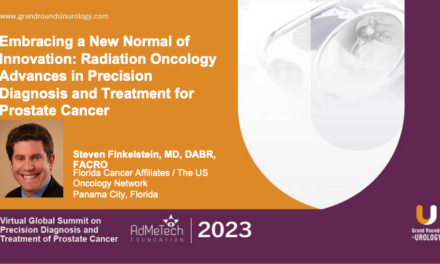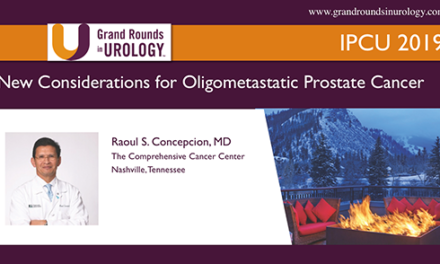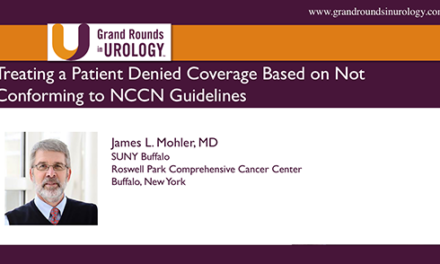Nelson N. Stone, MD, presented “Transperineal Mapping Biopsy: Does Technique Matter?” during the 25th Annual Southwest Prostate Cancer Symposium conference on December 11, 2021, in Scottsdale, Arizona.
How to cite: Stone, Nelson N. “Transperineal Mapping Biopsy: Does Technique Matter?” December 11, 2021. Accessed Jul 2025. https://grandroundsinurology.com/transperineal-mapping-biopsy-does-technique-matter/
Transperineal Mapping Biopsy: Does Technique Matter? – Summary
Nelson N. Stone, MD, Professor of Urology, Radiation Oncology, and Oncological Sciences at the Icahn School of Medicine at Mount Sinai and at the Derald H. Ruttenberg Cancer Center at Mount Sinai School of Medicine in New York, discusses transperineal mapping biopsy (TPMB). Dr. Stone opens his talk with data on prostate biopsy, a procedure done about 1.2 million times per year in the U.S., with 95 percent of those being transrectal ultrasound (TRUS) biopsy. He points out that, classically, treatment of localized disease has involved treatment of the whole gland which is technically challenging and oftentimes not successful. Dr. Stone addresses focal therapy and asks, “Can the treatment of a portion of the prostate give similar oncologic results and improved quality of life?” Dr. Stone illustrates limitations of using MRI to determine focal therapy eligibility, showing differences between focal therapy treatment strategies vs. actual pathology. He cites a study showing that MRI misses 73-89 percent of lesions smaller than 10mm in diameter, with approximately one-third of those being clinically significant. Dr. Stone turns then to TPMB, sharing a study showing the ratio of the number of biopsy specimens to prostate volume (prostate density) greater than 1.5 improves the prostate cancer detection rate in men undergoing transperineal biopsy of the prostate. Dr. Stone illustrates that by using the quadrant approach and identifying the area of interest, biopsies can be strategically mapped using a grid method. He then advocates for a unified approach to diagnosis and treatment with image fusion and mapping biopsy that can be registered to a biopsy program, which maps and records lesion locations in 2D and 3D and can include pathology results. Next, the Digital Imaging and Communications in Medicine (DICOM) file would be registered to a focal treatment platform. He then shares data on partial prostate gland ablation using TPMB. Dr. Stone concludes that treating a single quadrant as identified by MRI or using a hemiablation plan (left or right prostate) may leave unidentified clinically-significant prostate cancer behind. Partial gland ablation, Dr. Stone contends, should most commonly occur in both posterior quadrants, followed by the right or left posterior quadrants, and then a hemiablation. He states that, for focal therapy, a TPMB approach, which can be done under local anesthesia, should be considered.
About the 25th Annual Southwest Prostate Cancer Symposium:
Presented by Program Chairs Nelson N. Stone, MD, and Richard G. Stock, MD, this conference educated attendees about advances in the management of localized and advanced prostate cancer, with a focus on imaging, technology, and training in the related devices. It included a scientific session, as well as live demonstrations of surgical techniques. You can learn more about the conference here.
ABOUT THE AUTHOR
Nelson N. Stone, MD, is Professor of Urology, Radiation Oncology, and Oncological Sciences at the Icahn School of Medicine at Mount Sinai and chief medical officer at Viomerse, Inc.
Dr. Stone earned his medical degree from the University of Maryland in 1979. He completed a Residency in General Surgery in 1981 at the University of Maryland, followed by a Residency in Urology at the University of Maryland. He then completed a Fellowship in Urologic Oncology at Memorial Sloan-Kettering Cancer Center and a Research Fellowship in Biochemical Endocrinology at Rockefeller University in 1986. He was Chief of Urology at Elmhurst Hospital Queens from 1986-1996.
Dr. Stone has founded several medical companies and serves on the editorial board of many scientific journals. He is a member of many professional societies, including the Prostate Conditions Education Council, the Society for Minimally Invasive Therapy, the New York State Urological Society, the American Association of Clinical Urologists, and the American Urologic Association. Dr. Stone has participated in approximately 25 research studies on prostate cancer and has authored more than 500 articles, abstracts, and book chapters, primarily on prostate cancer. He invented the real-time technique for prostate brachytherapy in 1990 and has trained more than 5,000 physicians worldwide through his company ProSeed. His most recent company, Viomerse, creates synthetic body parts (phantoms) for surgical training and has recently released an extended reality remote training platform.




